Remedy for Repeated Implant Retained Denture Fracture-A Challenging Case Report
Ramu Reddy M1, Kiran Kumar Metta2, Sudheer Charry N3, Anulekha Avinash C.K.4, Chittaranjan B5
1 Professor, Department of Prosthodontics, Kamineni Institute of Dental sciences, Narketpally, Nalgonda, Andhra Pradesh, India.
2 Reader, Department of Conservative Dentistry and Endodontics, MIDSR Dental College and Hospital, Latur, Maharastra, India.
3 Professor, Department of Prosthodontics, Kamineni Institute of Dental Sciences, Nalgonda, Andhra Pradesh, India.
4 Reader, Department of Prosthodontics, Kamineni Institute of Dental Sciences, Nalgonda, Andhra Pradesh, India.
5 Professor and HOD, Department of Prosthodontics, Kamineni Institute of Dental Sciences, Nalgonda, Andhra Pradesh, India.
NAME, ADDRESS, E-MAIL ID OF THE CORRESPONDING AUTHOR: Dr. Anulekha Avinash .C.K, Reader, Department of Prosthodontics, Kamineni Institute of Dental Sciences, Narketpally, Nalgonda, Andhra Pradesh-508254, India. Phone : 8121319805, E-mail : anulekhaavinash@gmail.com
The most common site of fracture in a maxillary or a mandibular complete denture is along an anteroposterior line that coincides with the labial notch in in the denture which used to provide the frenum relief. Osseointegrated implants have been a boon to the patients who are completelly edentulous and are not satisfied with the conventional removable complete denture approach.Implant supported dentures have proven to provide superior retention and support for removable complete dentures. Nevertheless, fracture of the denture bases is a common complication of implant-supported mandibular overlay dentures,ecspecially when the artificial denture is opposing natural dentition. This article describes and illustrates a method of reinforcing implant-supported mandibular overdentures to overcome this problem.
Case Report
A 65-year-old male patient reported to the Department of Prosthodontics, with the chief complaint of fractured mandibular implant supported over denture [Table/Fig-1] due to which he was unable to wear his denture since one week. Patient was systemically healthy with no medical compromise. History revealed placement of two endosseous dental implants with ball attachments [Table/Fig-2] three years back and history of previous denture fracture one year back and new denture made, subsequently fracture of second set of denture occurred within the gap of six months. Intra oral examination revealed natural teeth in relation to 15,17,23,24,25. The radiographic investigation revealed well osseointegrated implants in relation to the lower arch. The main treatment objective was to overcome this repeated fracture of the lower denture. So it was planned to reinforce mandibular implant supported over denture with metal. As the patient is socially active, the fracture denture was temporarily repaired and given to the patient in order to provide minimum function.

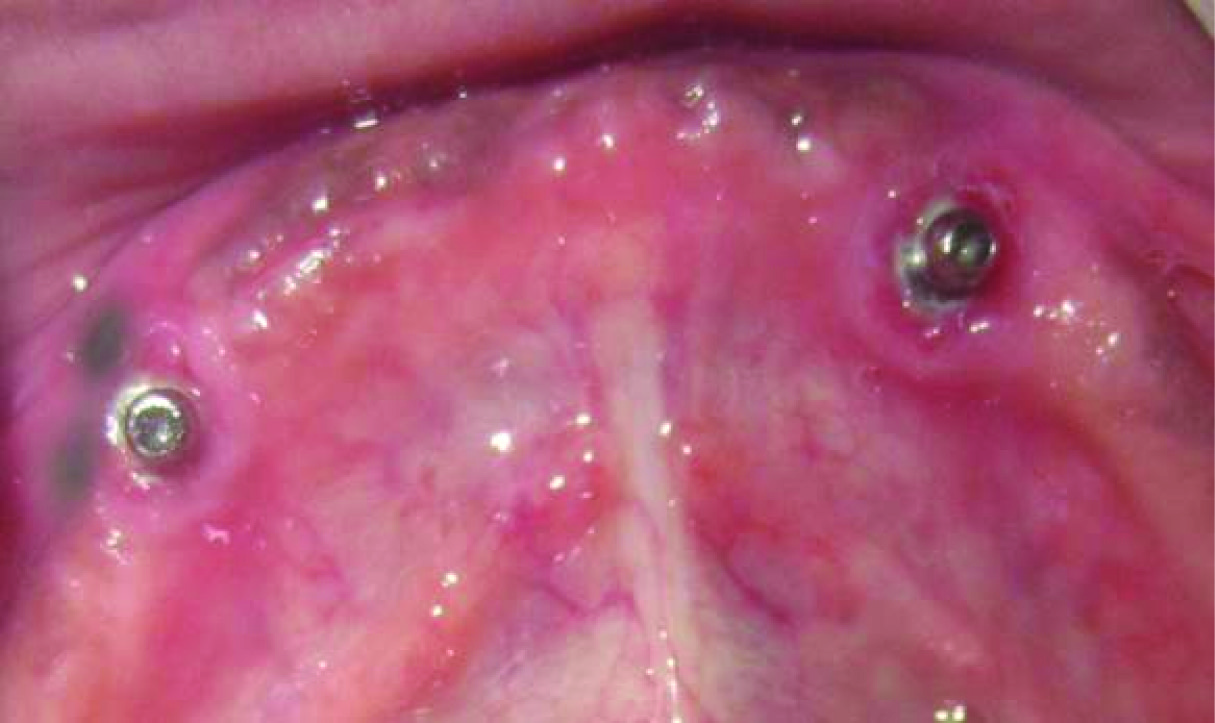
Procedure
Alginate impression of edentulous ridge along with the ball abutments were made with perforated edentulous tray and special tray fabricated with auto polymerizing acrylic resin. Border molding was done with the help of green stick compound and final impression was made with additional silicone. Metal housings were not removed from the existing denture as patient did not want to be edentulous. Definitive casts poured with type II dental stone. Relief wax was placed along the crest of the residual alveolar ridge and tissue stops were positioned. Since the metal housings were placed in the repaired denture, shaped block out was made over the ball abutments of the definitive cast with the similar dimensions [Table/Fig-3]. Further, definitive cast was duplicated with agar. Refractory cast was achieved, on which wax pattern was adapted corresponding to the planned metallic frame work design [Table/Fig-4]. The pattern along with the refractory cast was invested, burned out, casted, divested, finished and polished.
Block out of the master cast and ball abutmen
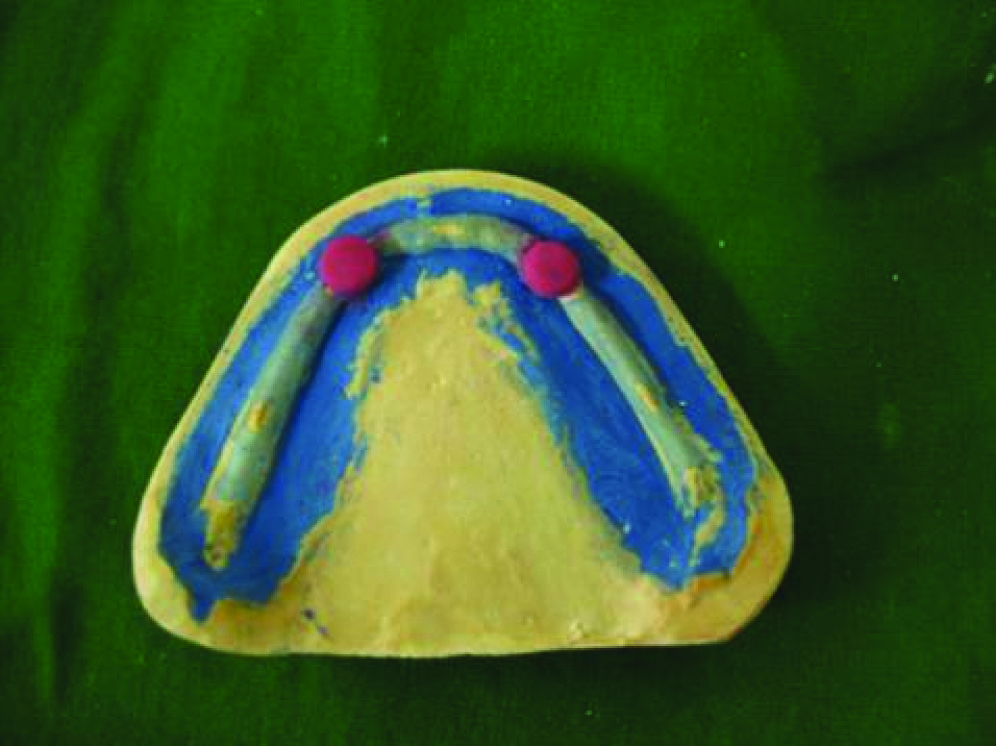
Wax pattern fabrication on the refractory cast

The framework was tried in patients mouth and was evaluated for the fit on the master cast [Table/Fig-5]. Denture base was fabricated over the frame work and bite registration was made. Teeth arrangement was done out and the trail denture bases were tried in the patient’s mouth [Table/Fig-6]. Wax up was done and denture was processed with heat cure acrylic resin. The mandibular denture was relieved from the area where the ball abutments were placed. The retentive housings elements were placed over the ball abutments [Table/Fig-7].and were picked up by the lower complete denture using auto polymerizing resin [Table/Fig-8].Finally the denture was evaluated for retention, stability and support [Table/Fig-9].The patient was kept under observation constantly for 6 months; patient is very much satisfied with metal reinforced implant supported over denture and has no complains of fracture of denture anymore.

Try in of trail denture bas
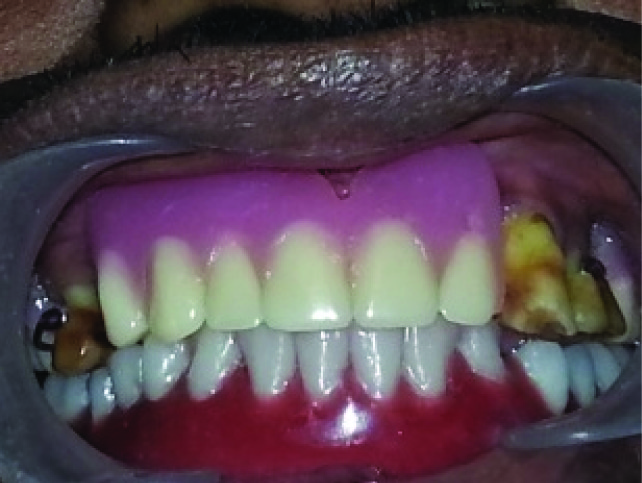
Metal housings in the mouth
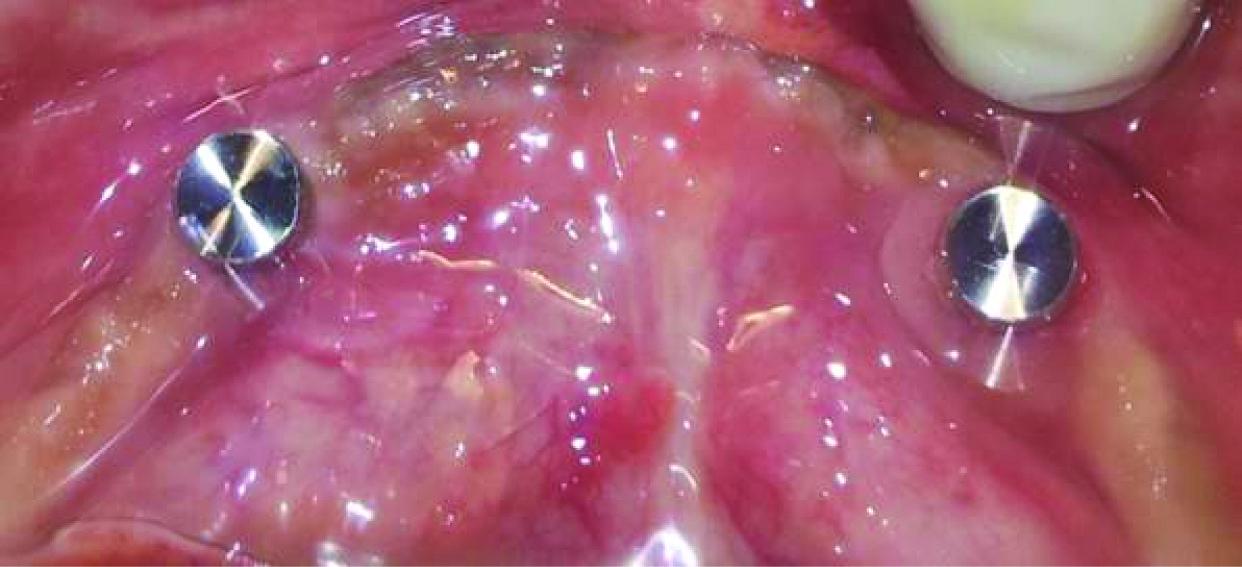
Pick up with auto polymerizing acrylic res

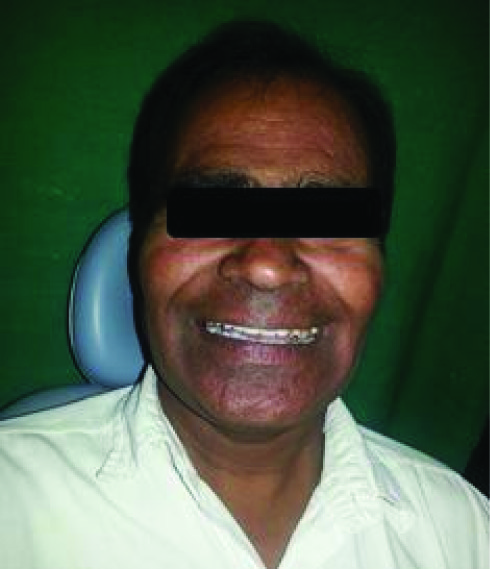
Discussion
Implant-retained over dentures are standard treatment options for rehabilitating conditions where the jaws are atrophied. The Mc-Gill Consensus statement of 2002 and the York consensus statement of 2009 discussed the advantages of the mandibular implant-retained over denture when compared to the conventional complete denture prosthesis. They are improved retention, stability, function, esthetics bone preservation, and physical and emotional health [1–3]. Despite of the advantages of implant supported over denture over the conventional complete denture there can be also chances of implant supported over denture to fracture. There are many reasons suggested in the literature leading to fracture of the denture base. They are occlusal disharmony, excessive occlusal forces, flexure and fatigue of the denture base as a result of alveolar resorption, thin spots in denture base, and impact as a result of dropping the denture, an artificial denture opposing natural dentition [4,5].
Fracture of denture bases tend to occur more frequently with implant-supported removable over dentures, particularly in the anterior portion when opposing natural dentition. This tendency to fracture is due to inadequate thickness of acrylic resin from the dimensions of the attachments, resulting in diminishing the longevity of the prosthesis and causing fracture frustration to the patient [6]. This article describes the procedure to solve the problem of repeated fracture of over denture which opposes natural dentition. Hence it was planned to reinforce implant supported over denture with Co-Cr metal frame work engaged with in the implant attachments, so as to prevent the repeated fracture of implant supported over denture.
The implant-retained overdenture for the mandible has been shown to be a highly successful prosthetic treatment similar to the fixed implant denture [7]. Primary advantage of implant-supported full bridges and dentures is that they function like tooth roots, which preserves jaw bone. Implants when used with the mechanical attachments provide excellent denture stability and retention. Further, there is better esthetics; with improved tooth position and occlusion, including improved occlusal load direction, increased occlusal function and maintenance of the occlusal vertical dimension. Apart from all these advantages hygiene conditions and home maintenance procedures are improved with an overdenture when compared to a fixed prosthesis in addition, implant-supported overdentures improve phonetics, the patient’s psychological outlook and quality of life. Dispite of all the advantages of the implant supported overdentures there are certain disadvantages especially when they are subjected to repeated fracture for various reasons. There are many causes leading to the fracture of complete dentures, which are mentioned in the literature [4].
In this case report the most probable cause for the implant supported lower denture to fracture could be natural dentition opposed by the artificial denture, decreased/inadequate thickness of acrylic resin in the anterior portion of the denture where the final attachments were positioned. Hence it was planned to reinforce metallic frame work into the implant supported over denture which reduce the problems of repeated denture fracture. Past reports suggests that the incorporation of metal frameworks may reinforce or strengthen removable prosthesis [8]. Incorporation of a metal frame work, metal reinforcing mesh, or woven or fiberglass-impregnated mesh have been recommended to improve resistance to denture fracture during function [9]. This would facilitate longer durability of the dentures.
[1]. Feine JS, Carlsson GE, Awad MA, Chehade A, Duncan WJ, Gizani S, The McGill consensus statement on over dentures. Mandibular two-implant-over dentures as first choice standard of care for edentulous patients. Montreal, Quebec, May 24- 25, 2002 Int J Oral Maxillofac Implants 2002 17:601-02. [Google Scholar]
[2]. Doundoulakis JH, Eckert SE, Lindquist CC, Jeffcoat MK, The implant-supported over dentureas an alternative to the complete mandibular denture J Am Dent Assoc 2003 134:1455-58. [Google Scholar]
[3]. Von Wowern N, Gotfredsen K, Implant-supported overdentures, a prevention of bone loss in edentulous mandibles? A 5-year follow-up study Clin Oral Implants Res 2001 12:19-25. [Google Scholar]
[4]. Darbar UR, Huggett R, Harrison A, Denture fracture—a survey Br Dent J 1994 176:342-45. [Google Scholar]
[5]. Morrow RM, Rudd KD, Rhoads JE, Dental laboratory procedures 1986 St LouisMosby:383 [Google Scholar]
[6]. Rodrigues AH, Metal reinforcement for implant-supported mandibular over dentures J Prosthet Dent 2000 83:511-13. [Google Scholar]
[7]. Steven J, Sadowsky. Mandibular implant-retained overdentures: A literature review J Prosthet Dent 2001 86:468-73. [Google Scholar]
[8]. Kaira Laxman Singh, Singh Richa, Single complete denture in mandibular arch opposing Natural dentition – a case report NUJHS Vol. 31:72-75. [Google Scholar]
[9]. Ahuja Swathi, Jain Vinay, (2013) Fabricating a mandibular implant supported over denture with a suspended frame work J Prosthodont Soc 2013 13(2):132-36. [Google Scholar]